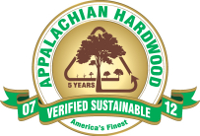 HIGH POINT, N.C. - The growth of the Appalachian Hardwood forest is outpacing removals by 2.45, an increase of five percent in the past five years.
HIGH POINT, N.C. - The growth of the Appalachian Hardwood forest is outpacing removals by 2.45, an increase of five percent in the past five years.
The hardwood resource in the 12 eastern U.S. states is banking more trees for the future, according to updated analysis by the U.S. Department of Agriculture. The greater inventory is the result of modern forest management, wise utilization and a decline in the world economy.
The 2012 review was commissioned by Appalachian Hardwood Manufacturers, Inc. (AHMI) as a followup to a 2007 study. The initial research found the Appalachian Hardwood forest was meeting the needs of the forest products industry without compromising those of future generations - sustainably. The five-year review completed in February found the growth to removal ratio has improved from 2.29 in 2007 to 2.45 in 2012 for the 344-county Appalachian Hardwood region.
“This assures hardwood lumber consumers that when they purchase products from the Appalachian region, they know the resource is sustainable,” said Tom Inman, AHMI President. “The forest landowners have done exceptional work in managing their forests for wildlife, water resources, recreation and timber for today and into the future.”
AHMI launched its “Appalachian Hardwood Verified Sustainable” campaign in 2007 to certify its members as producing, distributing and manufacturing goods from the region. The campaign educates wood consumers about the hardwood lumber resource and provides the research behind the findings.
Lumber certification is a complex issue that has multiple stakeholders from the individual landowner through the retailer of finished goods. AHMI has researched and developed programs to assist its members in making decisions that benefit both the environment and individual operations.
The research is based on the U.S. Forest Service’s Forest Inventory and Analysis which is compiled in each state by the U.S. Department of Agriculture. AHMI requested specific data from the 344 counties of the Appalachian Region from northern Georgia through western New York.
“Because of natural regeneration and forest management in the Appalachian region, we have an extremely stable timber base,” said Inman. “This updated analysis verifies it again, and more importantly shows the Appalachian Region is improving to 2.45 to 1. We believe this goes beyond basic sustainability and verifies an expanding resource and timber base for the future.”
The report also found changes in other areas:
· Forested land in the 344-county region increased 300,000 acres to 65.7 million acres in 2012
· More than 33 billion live trees are in the region, an increase from 32.7 billion in 2007
· The top species in the region are Soft Maple, Red Oak, White Oak, Hard Maple and Yellow Poplar
AHMI is a regional trade association headquartered in High Point, NC. Its mission is to promote the hardwood timber and products from the Appalachian Region of the eastern United States. The association’s bylaws dictate the producing region and these counties must meet elevation, soil composition and climate requirements to be included.
“The public is becoming more interested in sustainable resources and green building and our research proves that the Appalachian Hardwood Forest exceeds sustainability levels and definitions,” Inman said. “Consumers can be assured when they purchase hardwood products from lumber manufactured from AHMI members that the resource is sustaining more growth than harvest. The data shows that Appalachian is verified sustainable and growing.”
Complete research details are available at www.appalachianhardwood.info.
Source: Appalachian Hardwood Manufacturers Inc.





Have something to say? Share your thoughts with us in the comments below.